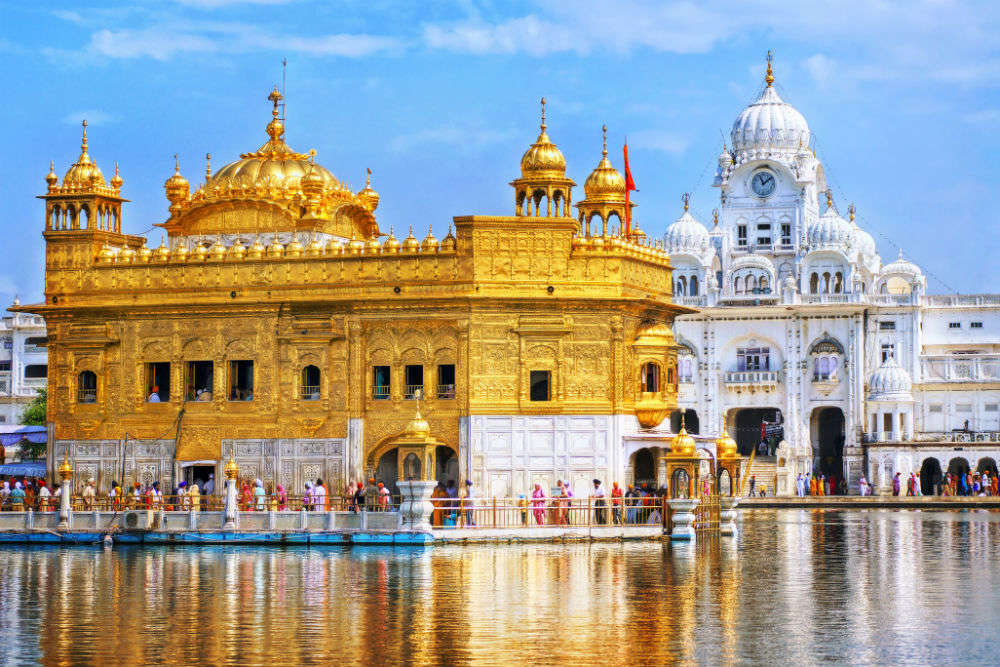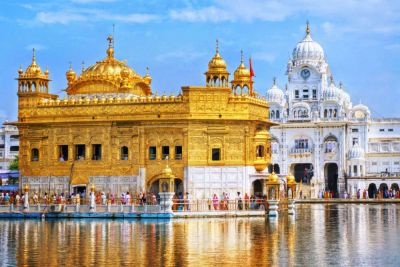

The Golden Temple, also known as Sri Harmandir Sahib, is a glistening jewel of Amritsar and a place of great beauty and sublime peacefulness. Originally built in 1604 by the fifth Sikh Guru, Guru Arjan Dev Ji, this glittering temple is surrounded by a large holy tank and has a unique Sikh architecture. As the most important pilgrimage site of Sikhism, the temple is open to people of all faiths, allowing everyone to experience its serene ambiance and listen to the continuous recitation of the holy scriptures. Inside, the holy scripture of the Sikhs, the Guru Granth Sahib, is reverently placed. Visitors can also partake in Langar, a community meal provided for free for anyone, regardless of their background or religion. The Golden Temple is not just a place of spiritual solace, but also a symbol of brotherhood and equality. Every visitor is expected to cover their head and remove their shoes as a sign of respect.
The Wagah Border Ceremony is a daily military practice that the security forces of India (Border Security Force, BSF) and Pakistan (Pakistan Rangers) have jointly followed since 1959. This ceremony takes place every evening before sunset at the Wagah border, which is situated near Amritsar. It starts with a blustering parade by the soldiers from both sides, and ends up in the perfectly coordinated lowering of the two nations' flags. The atmosphere is electrifying with the cheer of the crowd on each side of the border. It's a display of patriotic fervor, military precision, and a unique cultural performance that makes it a must-see. Visitors should remember to carry an ID and should expect high security due to the sensitive nature of the border. Despite the rivalry, there's a sense of harmony and shared history that permeates the air during this daily ritual.
Jallianwala Bagh is a public garden that houses a memorial to commemorate the massacre of hundreds of Indians by British forces on April 13, 1919. The event marked a turning point in India's struggle for independence. Visitors enter through a narrow alley that opens up into a peaceful garden, but the bullet marks on the walls and the Martyr's Well are sobering reminders of the tragedy that took place here. The site now hosts a poignant memorial, a gallery, and a museum that delve into pre-independence history, giving visitors a sense of the gravity of the freedom struggle. Throughout Jallianwala Bagh, information plaques recount the events of that fateful day and pay homage to the lives lost. This activity is a somber reminder of the past and a crucial piece of history for anyone looking to understand India's journey to independence.
Gobindgarh Fort is a historic fort located in the heart of Amritsar. It was first established by the army of Gujjar Singh Bhangi of the Sikh Misls, later rebuilt by Maharaja Ranjit Singh, and eventually used by the British. After being inaccessible to the public for years, the fort was opened to visitors in 2017. Now, it serves not only as a testimony to the region's history but also as a site for cultural entertainment. Inside the fort, you can enjoy 7D shows, live performances, and exhibitions depicting Punjab's rich past. The fort also hosts 'Whispering Walls', a light and sound show that is held in the evenings. This show spectacularly depicts the history of Punjab with the fort as its canvas. The visit to the fort is an immersive experience in history, culture, and technology.
The Partition Museum is dedicated to the memory of the Partition of India in 1947, the largest mass migration in human history. It's the first museum worldwide to focus on the stories and traumas of the millions who had to leave behind their lives when the boundaries between India and Pakistan were drawn. Located at the historic Town Hall of Amritsar, this museum offers interactive galleries, multimedia stations, and an archive of narratives and artifacts donated by those who witnessed the partition firsthand. The personal stories, photographs, and objects bring alive the event that shaped the subcontinent's present-day reality. It's an emotional journey through a poignant chapter of history, aiming to heal wounds through remembrance and education. The museum is a place for reflection, providing an insight into the resilience and courage of those affected.
Pul Kanjari is a historical site situated near the India-Pakistan border, about 35 kilometers from Amritsar. It is one of the many heritage sites associated with Maharaja Ranjit Singh, known as the ‘Lion of Punjab’. The legend goes that Maharaja Ranjit Singh and his troops would stop here on their way to Lahore and it's known for a bridge and a temple dedicated to the courtesan Moran Sarkar, who caught the Maharaja's fancy. It features a memorial, a mosque, a Hindu temple, and a Gurudwara, symbolizing the region's composite culture. Visitors can learn about this interesting facet of Punjab's history while experiencing the serene ambiance of a site that's less frequented by tourists. The picturesque setting and architecture are captivating, making it a worthwhile visit for those interested in the lesser-known historical tales of Punjab.
The Maharaja Ranjit Singh Museum was once the summer palace of the first Maharaja of the Sikh Empire, Maharaja Ranjit Singh. It has now been converted into a museum which showcases artifacts related to the Maharaja and the Sikh period of history. The museum boasts several galleries displaying old coins, manuscripts, and antique weaponry that belonged to the Sikh warriors. There are paintings depicting various battles, the lifestyle of the sovereign, and the exuberance of the Sikh courts. The museum's garden is a tranquil spot where visitors can take a break and reflect on their deeper understanding of the region's rich culture. It's a great destination for history buffs and those curious about the legacies of Punjab's royal past.
Khalsa College features a stunning example of Indo-Saracenic architecture, offering an educational visit that includes both academic history and architectural appreciation. Established in 1892, the college was built to provide higher education in the humanities, sciences, and the arts in the northern province of India. As a visitor, you can stroll through the vast campus and admire the distinct red brick buildings adorned with domes, turrets, and arches. The grand architecture stands as a testament to the area's blend of cultural aesthetics and its promotion of education. This activity is ideal for those with an interest in history, education, and the beautiful architecture of India. Although Khalsa College is an educational institution, visitors can usually walk around the campus and marvel at the historical buildings, with prior permission from the college administration.
The Tarn Taran Sahib is a prominent Sikh gurudwara located around 22 kilometers from Amritsar city. Founded by the fifth Sikh Guru, Guru Arjan Dev Ji, it has a history dating back to 1590. This gurudwara is renowned for its large sarovar (holy pool), which is believed to be the largest among all the Sikh shrines. It's considered to have healing properties, and many pilgrims visit with the homage of washing away their sins in the sacred waters. The architectural style of Tarn Taran Sahib reflects the typical Sikh architecture with gold-leafed domes and white marble structures. Every month during the day of Amavas, a large gathering takes place, and the gurudwara complex bustles with the spirit of devotion. Spending time here and experiencing the soulful kirtans (hymn singing) is a manifestation of Sikhism's practices of community and spirituality.
Baba Atal Tower is a nine-story octagonal tower situated within the premises of the Golden Temple complex. Standing tall at a height of about 40 meters, it is named after Baba Atal Rai, the son of Guru Hargobind Ji, the sixth Sikh Guru, and is one of the tallest structures in Amritsar. This site is associated with legends of Baba Atal Rai's spiritual prowess and grants visitors with panoramic views of the entire Golden Temple complex and the surrounding city from its top floor. As travelers ascend the tower, they notice murals and frescoes depicting various stories from Sikh history. It's not only a site of pilgrimage but also a place that offers a unique perspective of Amritsar's skyline and the juxtaposition of ancient architecture with modernity. The peaceful surroundings and architectural beauty attract not just the devout but also history and art enthusiasts.
